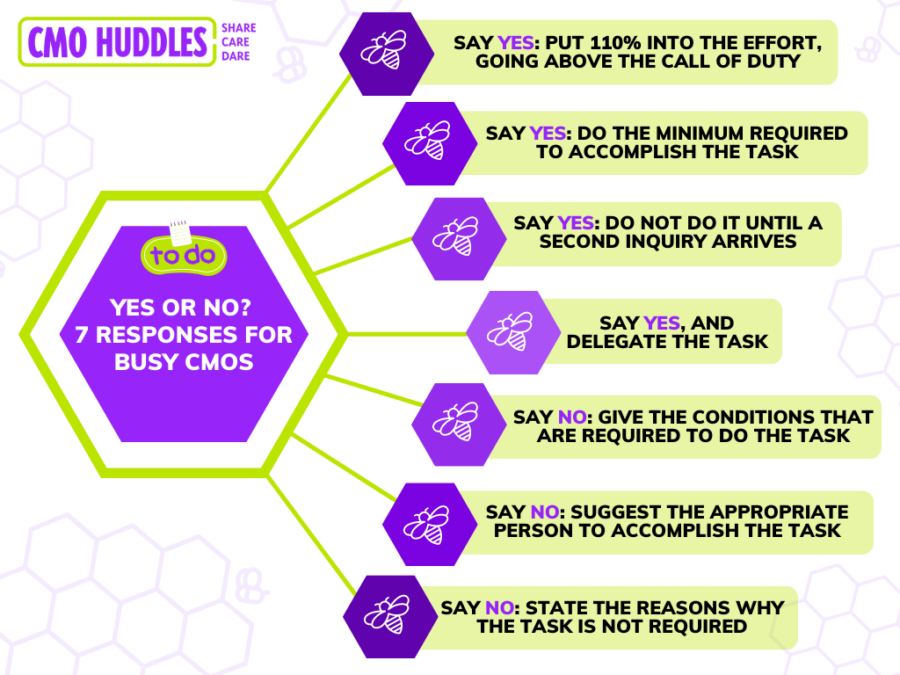
The Power of the Strategic Response: 7 Ways to Handle Requests as a CMO
The modern B2B CMO has a lot on their plate. An overflowing inbox, a jam-packed calendar, questions coming every which way from the board, the C-Suite, direct reports, and the marketing team in a role that wears a stack of hats on the verge of tipping over.
Unfortunately, even the most superpowered CMOs don’t have an extra 10 hours a day to get things done, so it’s incredibly important to be able to prioritize one’s time and efforts. And while CMOs know they can’t say yes to every request that comes in, many find it twice as hard to say no.
But what if you could rate incoming requests on a sliding scale, and wherever they fell there was a strategically relevant way to say Yes or No? Yep, a hard “Yes” or a hard “No” are not your only options. Lucky for you, JD Dillon of Tigo Energy shared seven ways to respond to any request in a CMO Huddle, and gave the ok to share them here on a scale of hard “Yes” to hard “No.” Read on to take control of your schedule and deliver better results for your business.

Say Yes: Put 110% into the effort, going above the call of duty
It’s time to only do the things that you can uniquely do, and as CMO that’s to build a marketing-led growth motion that will have employees, customers, and prospects raving about your service and your brand. So think carefully about the request on the table — if it’s going to move the needle, it’s time for 110%.
Say Yes: Do the minimum required to accomplish the task
Sometimes one strategic initiative needs more pressing attention than another, but you can’t let the one that will be important later go by the wayside. In this case, make sure you can recognize the difference between “urgent” and “will-be-urgent-eventually,” so you can tinker away at the latter if you can’t give it your all. No one wins if you’re burnt out.
Say Yes: Do not do it until a second inquiry arrives
If your non-marketing peers have a lot of ideas for what the marketing function should do, don’t dismiss them outright. Listening, after all, is one of a CMOs greatest strengths, so taking in what they say and taking it seriously is important.
However, it’s also a necessity to weigh them carefully. If you’re unclear whether an ask is critical to the business’s success, consider delaying your response until a second inquiry arrives. It might be a better time later.
Say Yes, and delegate the task
If you’re only doing the things that you can uniquely do, then your direct reports and your marketing team exist to do the same—which is to support and grow all marketing activities. Some requests are important, which is why the best thing you can do is delegate it to someone on your team who’s got the skills and knowledge to handle it. You’ll free up your own time and empower your team members at the same time.
Say No: Give the conditions that are required in order to do the task
Yes, it’s time to say no! Despite what social pressures may tell you, saying no doesn’t have to be bad. The way a marketing leader responds to a request can show that they are thoughtful and strategic in their decision-making and committed to the success of the business.
Sometimes a request comes in that you’d love to do, but there are certain conditions that have to be met first. Instead of saying no outright, give the requester the conditions that need to be met in order for you to take on the task. It’ll show that you’re willing to work together to get things done.
Say No: Suggest the appropriate person to accomplish the task
If you get a request that’s just not your cup of tea, it’s okay to say no! But don’t leave the requester high and dry – suggest someone else who could handle the task (this is a little different than delegating in that you aren’t the one actually doing the delgating). You’ll still be building relationships and showing that you care about getting things done.
Say No: State the reasons why the task is not required
Finally, there are those requests that just don’t make sense for your business. If you get one of these, say no, AND explain why the task isn’t necessary. It’s that “why” that’s the most important—if you can clearly and strategically lay out why a request doesn’t make sense, then they won’t feel like it was a no for “no’s” sake. Prioritizing your time and resources on things that really matter will inspire others to do the same.
So there you have it—seven ways to respond to requests that’ll help you take control of your schedule, build relationships, and still be an awesome CMO. For more tips like these (and if you’re a busy B2B CMO looking for a force-multiplying community of like-minded peers), check out cmohuddles.com. You can’t outwork this job, but you can outsmart it.